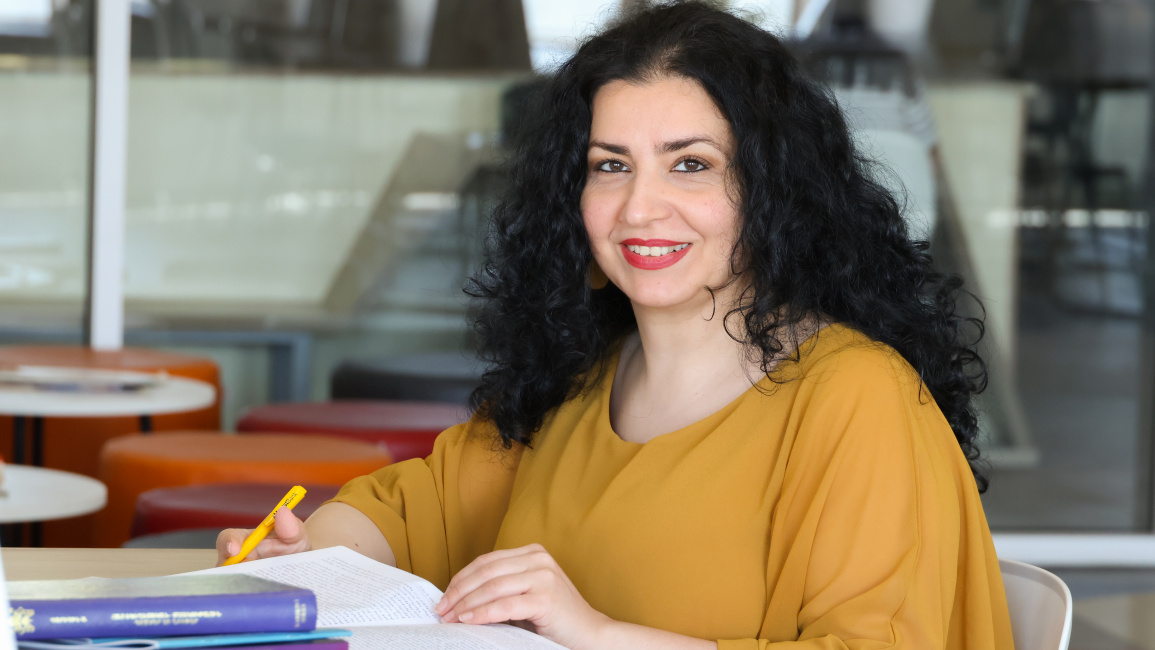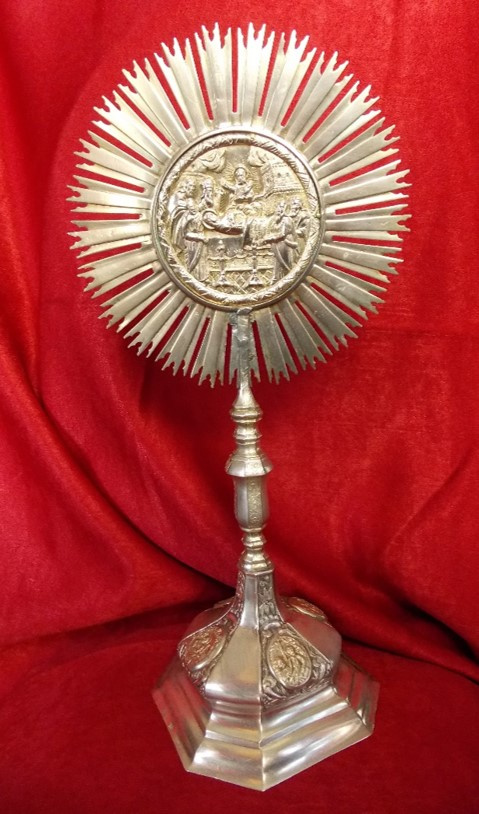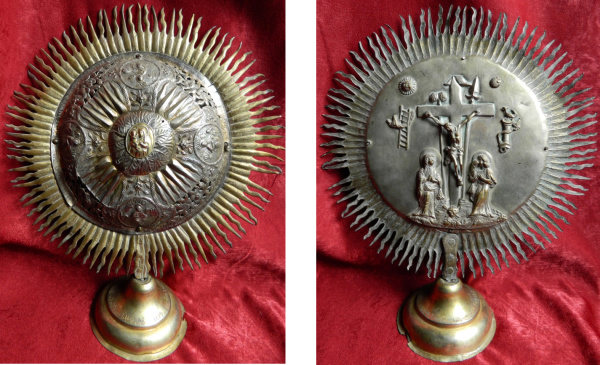April 15, 2024 | 12:39
Research
Publications and scientific journals
International cooperation
"Altar radiances" ritual object is unique to Armenian Church - YSU Lecturer Mariam Vardanyan
Mariam Vardanyan, Lecturer of the Chair of History and Theory of Armenian Art at the YSU Faculty of History, studied Armenian and non-Armenian ritual objects in the collections of the Armenian Diocese of Romania. Her article, published in a high-ranking international journal, presents evidence that the ritual object "Altar radiances" is unique only to the Armenian Church.

The article titled "Altar Radiances among Ritual Objects of Armenian Church (On the Example of the Collections of Armenian Diocese of Romania)", authored by the YSU lecturer, was published in the 2023 "Actual Problems of Theory and History of Art" international high-ranking journal. Ritual objects such as chalices, altar crosses, hand held crosses, relics receptacles, right arms, altar radiances, silver book covers and other objects are at the core of her research study.
Scientific Group to Be Formed for Studying Armenian Cultural Heritage of Romania, Involving Professors from Chair of History and Theory of Armenian Art
Mariam Vardanyan mentioned that initially she specialized in the history of Armenian silversmithing and was not interested in the study of ritual objects.
"I was more interested in secular objects, including jewelry. Everything changed in 2012, when the study of the Armenian cultural heritage in Romania began through the joint efforts of Professor Levon Chugaszyan, Head of our chair, my scientific supervisor, Doctor of Arts, and Bishop Tatev Hakobyan, Leader of the Armenian Diocese of Romania," she noted.
With the purpose of studying the Armenian Cultural Heritage of Romania, a scientific group was formed, which included professors from the Chair of History and Theory of Armenian Art. Mariam Vardanyan, as a researcher of artistic metal samples, was included in that group.
"This work also became crucial; after that, I transitioned from studying secular objects to studying ritual objects. My published articles are still on ritual objects in the collections of the Armenian Diocese of Romania. There are several reasons for this; the collection is very diverse and rich in unique samples. Not only Armenian, but also Romanian, Austro-Hungarian, Polish, Russian and other samples are presented here," Mariam Vardanyan emphasized.

"Altar Radiances" Object in Any Museum or Private Collection Worldwide is of Armenian Origin
Representation of ritual objects from different countries created an opportunity for Mariam Vardanyan to conduct research on a broader scale, including the study of non-Armenian ritual objects. Speaking about her research, she stated that these samples had never been studied, published or introduced into scientific discourse. Therefore, Mariam Vardanyan's articles on this topic are the first of their kind.
While studying the artistic metal collection of the Armenian Diocese of Romania, Mariam Vardanyan found it more expedient to present each type of ritual object separately, referring to their nature, characteristic artistic features, to emphasize the differences between Armenian ritual objects and those from Eastern and Western Christian churches.
"Altar radiances are exceptional objects. In my article, I presented their uniqueness through comparisons and proved that these objects are unique only to the Armenian Church. And if there are similar objects of unknown origin in any museum or private collection worldwide, or there are unknown photos of such objects, then the "roots" of these objects should be sought in the ritual objects of the Armenian Church," pointed out the researcher.
Altar Radiance: One of Ritual Objects Decorating the Holy Table of Armenian Church, Symbolizing the Invisible Existence of Christ
Mariam Vardanyan, touching upon the significance of altar radiance, mentioned that it is one of the ritual objects that decorate the Holy Table of the Armenian Church.
"The comparison between the structure of Christian churches' Holy Tables and the objects placed on them revealed that altar radiances were created and introduced in the Armenian churches after the 17th century, influenced by Western churches. The western monstrance served as an example for the creation and artistic design of the object," she emphasized.
In this context, the YSU lecturer mentioned that radiance in the Holy Tables symbolizes the invisible existence of Christ, and in the New Testament, Christ is often compared to the sun.
"In Christian iconography, the sun symbolizes resurrection and immortality, and the radiance symbolizes the awareness and concentration of divine power," added M. Vardanyan.
Studying Altar Radiances Also Led to Uncovering Names of Romanian-Armenian Silversmiths and Jewelers
The study of altar radiances in the collections of the Armenian Diocese of Romania revealed that despite being created around the same time, they have distinct manuscripts and different creation styles, indicating that they were made by different masters.
"While it remains uncertain whether the object was created by an Armenian or a Romanian master, it is undeniable that all the examples were made by order of Armenians, as the Romanian Church does not use such objects," said the YSU lecturer.
According to Mariam Vardanyan, studying altar radiances also led to uncovering the names of Romanian-Armenian silversmiths and jewelers.
"The name of a local Armenian silversmith was written on one of the samples. The object was made in Botosani, Romania, and the inscription tells: "CREATED BY "PƏHƏXLƏEANC" ASTVACATUR". This fact holds significant importance as the names of Romanian-Armenian silversmiths or jewelers were not known, but there were only reports that jewelers and silversmiths also worked in the community. As part of the study of the collections of the Armenian Diocese of Romania, we successfully identified the names of two Armenian masters," pointed out M. Vardanyan.
YSU Lecturer Used Both Armenian and Foreign Sources in Study

Mariam Vardanyan, while presenting her research process, mentioned that she works on articles for a long time, getting to know the literature related to the given topic as completely as possible.
"Currently, the existence of various platforms (for instance, academia.edu, Jstor, etc.) has made the study process both easier and more complicated, making it more interesting. Various studies, different opinions, and questions give an opportunity to look at the topic from different perspectives, sometimes paying attention to such questions that you have never thought about," said the researcher.
In her study, she used both Armenian and foreign sources. In this context, she emphasized that Armenian ritual objects are very little studied, and the list of used literature predominantly comprises research studies of other Christian churches related to ritual objects.
Study of Other Ritual Objects Continues
The YSU lecturer is currently included in the scientific group studying the collection of the "Artak Manukyan" Museum in Tehran as part of the thematic grant offered by the Higher Education and Science Committee of MoESCS RA, again focusing on the study of ritual objects. Her field of study also includes arks.
Mariam Vardanyan has published 12 articles in scientific journals and anthologies (both in Armenia and outside Armenia), and 4 more articles are submitted for publication. She is also the author of 21 encyclopedic articles, which are included in the German "Saur General Artist Lexicon: The Visual Artists of All Times and Peoples" encyclopedia ("Saur Allgemeines Künstlerlexikon: Die Bildenden Künstler aller Zeiten und Völker"). This encyclopedia has many volumes, encompassing artists from around the world. The encyclopedia has been renamed and currently has the title "De Gruyter General Artist Lexicon: The Visual Artists of All Times and Peoples" ("De Gruyter Allgemeines Künstlerlexikon. Die Bildenden Künstler aller Zeiten und Völker").

